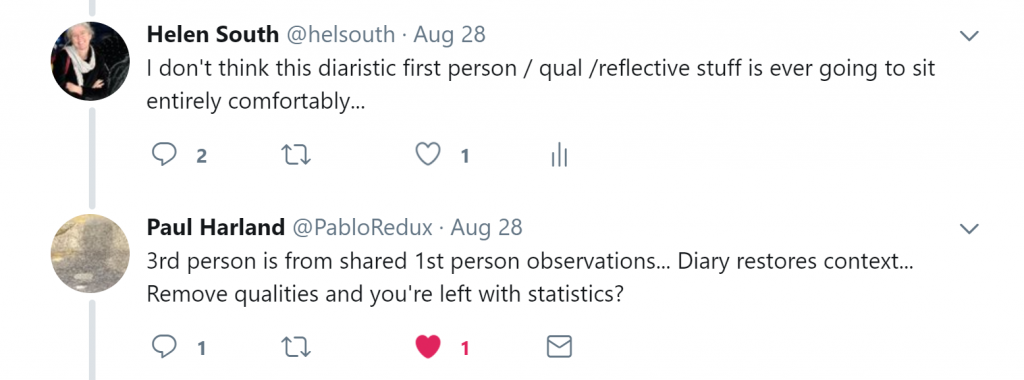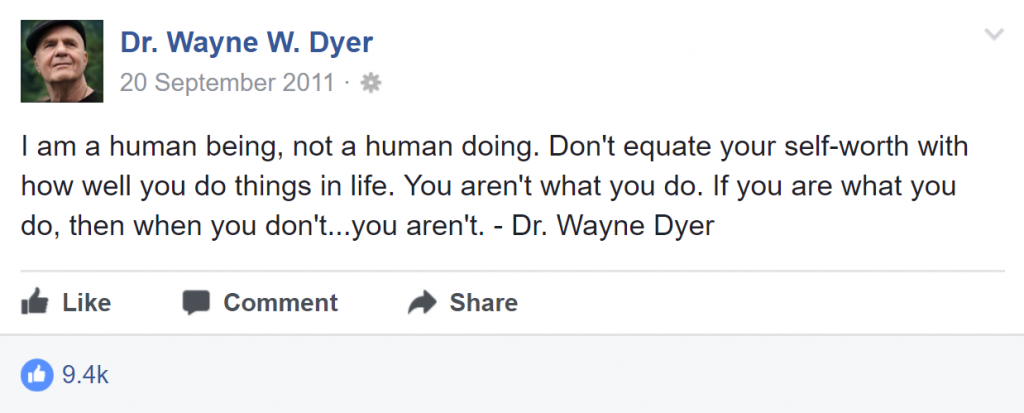The Ought Educator
Some of my most interesting insights this session were generated not by my own initiative, but by a student’s questions about Mead’s theory of the social self.
We were talking about Mead’s (1934) notion of the social construction of the ‘I’ and the ‘Me’, and comparing these with Freud’s ideas about id, ego and superego. The conversation connected with some thoughts I’ve been having about class and role reflected in art history. In these old paintings with these incredible costumes, there’s a strong sense of the person as inhabiting a persona; they are stepping into that dress, into that space in the painting, until they pass away and the next-in-line figuratively – and almost literally – fills their shoes. The real human being almost disappears under the weight of history and expectation…. I imagine the person stepping back from the painting and the whole thing deflating like an empty balloon.
So then, stepping off from that line of thought around images, and Mead’s ideas about construction of self, I’m thinking about mirrors and how unreliable self-evaluation can be, particularly when compared against the self society creates for us.
Self-perception presented as a distorted mirror is a familiar trope, common in depictions of eating disorder. Is the mirror ever not distorted? Certainly our ability to see and recall anything might be questionable: even the value of an eyewitness account in court is the subject of debate (Yarmey, 2001). We know that memories can be unreliable; they are not a verbatim record, and rather than solidified by being recounted, they created through progressive embellishment at every retelling (see Marsh, 2007). So why do proponents of reflective practice place such a high value on self-evaluation?
Self-evaluation among students is similarly unreliable; studies find that student-self evaluation varies between individuals, peers and expert assessors (Arthur, 1995; Babaii, Taghaddomi, & Pashmforoosh, 2016).
So how should I, as an educator, trust my ability to judge my own work?
I recently experienced this with a presentation. I was tired, and stumbled over the acknowledgement of country – something I found distressing, as I take it very seriously. Through the lecture, I felt quite muddled. I was depressed afterward, wondering how I was suited for such a people-facing profession – like many people, I loathe public speaking. However, on replaying the lecture, I found that it wasn’t as bad as I had thought. Most of the content flowed well and made sense.
Reflection, while in many regards a subjective technique, needs to be grounded in some objective reality. I need to draw on hard data, clear images, and to set the perceived image against the actual, using known measures. Yardsticks.
Subjectivist perspectives reject the scientific method, disdaining it as reductionist. I’m not convinvced. While I can only ever know my own perspective, this doesn’t mean that there isn’t an objective reality. My limited view doesn’t make that objective reality any less real. My job, as a researcher, is to reduce the gap between reality and my perception of it. But in that claim of reductionism, we can find the valuable connections that objectivist methods often discard. Interestingly, and in true constructivist fashion, it was a discussion that provided this insight:
The module exercise asking us to explore our ideas about ‘the ideal teacher’ allowed me to ground reflection in familiar psychological theory. Asked this question, I immediately think of Higgins’ well-known description of the social construction of multiple selves: self-discrepancy theory, in which Higgins (1989) articulates the tension between the actual, the ideal, and the ought self. This question asks us to consider an aspect of our ideal selves (as educators), and in doing so, we become acutely aware of the disparities between that ideal, the expectations held for us by others, and the realities of our work.
Higgins theorizes that, in addition to our ‘actual’ self, we have an ideal self (the aspirational attributes defined by ourselves or others as desirable), and an ought self (defined by fulfilling what we see as obligations or responsibilities). Discrepancies between the actual and ideal self may lead to disappointment, dissatisfaction and frustration; while discrepancies between actual and ought self may lead to anxiety, fear and alienation.
For the teacher in contemporary higher education – and particularly in online education – the discrepancy between actual, ideal and ought is substantial and, I contend, largely irreconcilable. Our ideals are fueled by notions of pedagogy formed in a different time and place, with different people – classrooms and children, and if adults, adults with the desire to learn. From Vygotsky to Freire, rich, contextualised relationships and commitment to learning are at the center of education. For the contemporary teacher, learning is often distant – whether at the extreme remove of online education, or in the large classroom where often minds, if not bodies, are absent. Even given the desire to learn, the adult learner is time-poor and rarely very present. Meanwhile, the educator is often paid poorly by the hour, with little contact time and limited resources, but expected to deliver positive analytics and keep up their end of departmental KPIs.
Blustein and Noumair (1996) refer to a breadth of sociological and psychological theory around the social construction of self, noting that Erikson regards “formation of a coherent Ego” as the primary occupation of adolescence (p. 433). The authors go on to suggest that identity is formed in a relational context (p. 435). That vocation is integrally connected with identity is thus not simply to do with its occupation of our time, but that it offers a myriad of ways in which to build and reinforce social bonds, at the same time as its significance is a mutually agreed-upon social fact.
Even at an anecdotal level, the notion of vocation as an aspect of identity is well established: we answer the question “what do you do” with “I am a bricklayer”. This idiom is frequently spoken to by self-help gurus:
Despite exhortations to the contrary, we are very much what we do. Self-discrepancies contained within the vocational domain are a source of negative affect – unhappiness, frustration or anxiety – that only looks to become worse as universities move to reduce teaching time, casualize the workforce and lower wages.
The next step, I think, is to identify ways to reduce those discrepancies. This means developing an understanding the limits of the systems – VET frameworks and university policy and practice; it means examining the literature and understanding the goals, attitudes and behaviors of students; and it means combining an understanding of pedagogy and the affordances of our technological infrastructure. By applying these understandings to bridge gaps and overcome the obstacles I encounter as an educator, I can find a central point where all my selves are better aligned.
References
Arthur, H. (1995). Student self-evaluations: How useful? How valid? International Journal of Nursing Studies, 32(3), 271-276. doi:10.1016/0020-7489(94)00043-J
Babaii, E., Taghaddomi, S., & Pashmforoosh, R. (2016). Speaking self-assessment: Mismatches between learners’ and teachers’ criteria. Language Testing, 33(3), 411-437.
Blustein, D. L., & Noumair, D. A. (1996). Self and identity in career development: Implications for theory and practice. Journal of Counseling & Development, 74(5), 433-441. doi: 10.1002/j.1556-6676.1996.tb01889.x
Boud, D., & Falchikov, N. (1989). Quantitative studies of student self-assessment in higher education: A critical analysis of findings. Higher education, 18(5), 529-549.
Positive about self-evaluation – Babaii, E., Taghaddomi, S., & Pashmforoosh, R. (2016). Speaking self-assessment: Mismatches between learners’ and teachers’ criteria. Language Testing, 33(3), 411-437.
Higgins, E. T. (1989) Self-discrepancy: A theory relating self and affect, Psychological Review, 94, 319-340. doi: http://dx.doi.org/10.1037/0033-295X.94.3.319
Marsh, E. J. (2007). Retelling is not the same as recalling: Implications for memory. Current Directions in Psychological Science, 16(1), 16-20. doi 10.1111/j.1467-8721.2007.00467.x
Mead, G. H. (1934). Mind, self and society from the standpoint of a social behaviorist. C. W. Morris (Ed.). Chicago: University of Chicago Press. Retrieved from https://brocku.ca/MeadProject/Mead/pubs2/mindself/Mead_1934_toc.html
Wayne Dyer (2011). In Facebook [Author Page]. Retrieved August
15, 2017, from https://www.facebook.com/drwaynedyer/posts/10150322836021030


